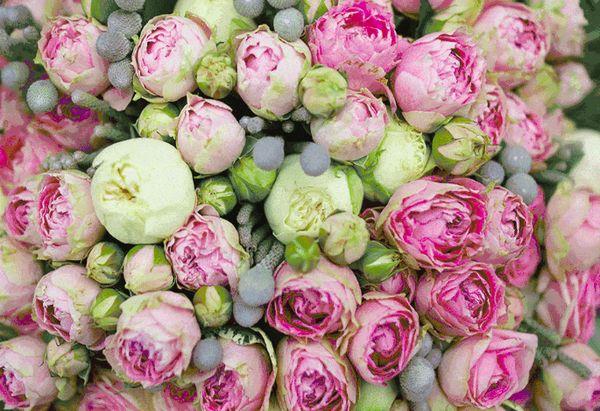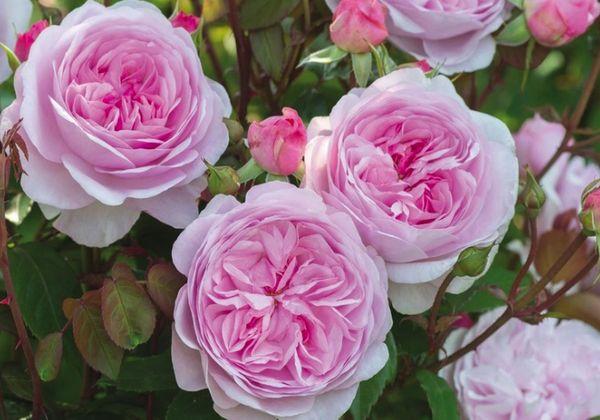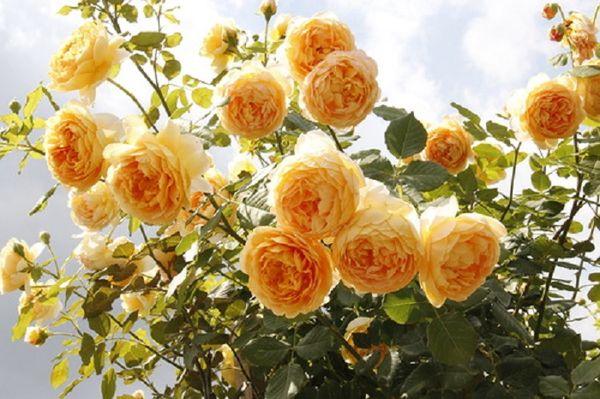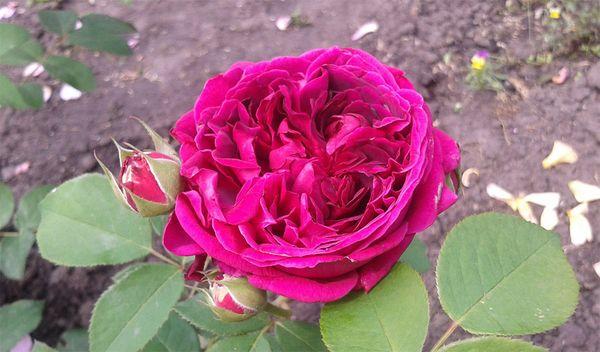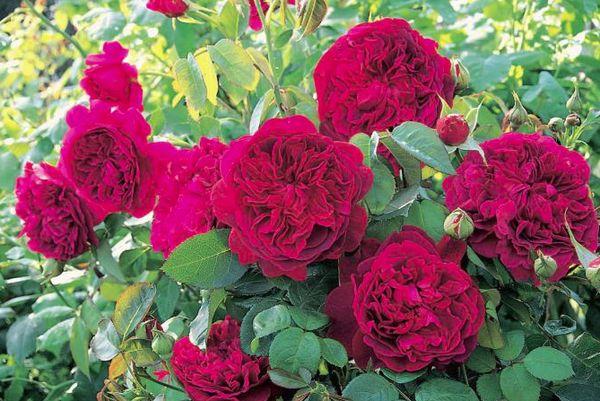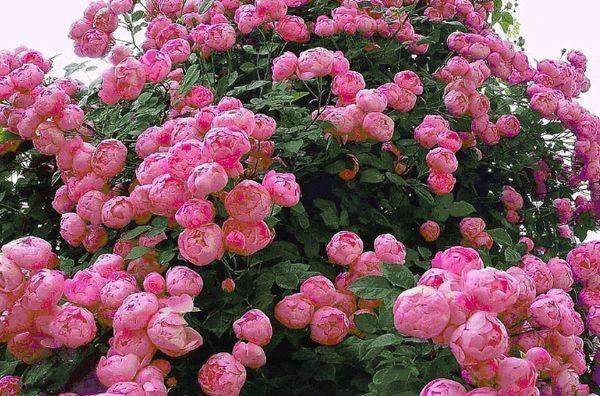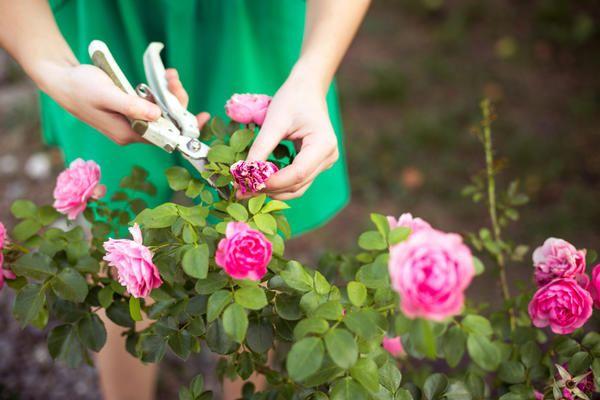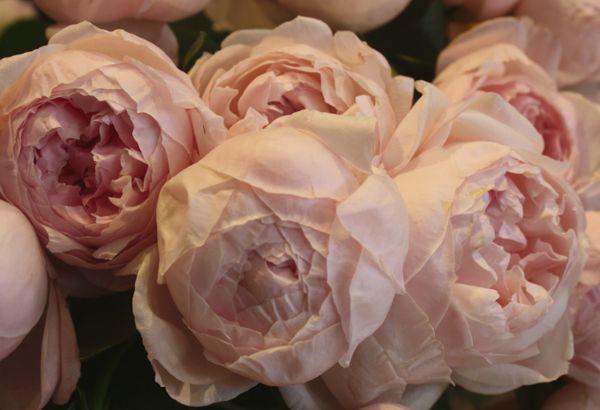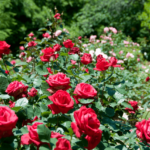Peony roses are lush flowers similar to spring peonies. They were bred in the eighties by a farmer from England, David Austin. 30 years earlier, he saw antique roses at a French exhibition, which he really liked. Since then, David Austin has been delirious with the desire to develop roses similar to the old ones, while they had to be resistant to diseases, bloom repeatedly, have a beautiful bush shape, a pleasant aroma and different colors.
- General information about flowers
- Varieties of peony roses
- Pink varieties
- Constance Spray
- Eglantine
- Miranda
- White varieties
- Snow Goose
- Tranquility
- Claire Austin
- Yellow varieties
- Graham Thomas
- Golden Celebration
- Pat Austin
- Red varieties
- Tradescant
- William Shakespeare
- Benjamin Britten
- Othello
- Timing and rules for planting in open ground
- Tips for caring for roses
- Watering and fertilizing
- Covering flowers for the winter
- Pruning roses
- Disease Prevention
- Breeding methods
- Peony roses in the garden
General information about flowers
Peony roses or David Austin hybrids are known all over the world. They are renowned for their beautiful bright flowers, low susceptibility to infection, adaptability to different weather conditions and incredible aroma. The surprising thing is that in cloudy weather their pleasant smell intensifies. The bushes grow quickly and do not produce wild growth. They have large buds.
Varieties of peony roses
There are quite a lot of peony roses, about 200 species, they have a wide variety of colors and shades. Roses are conventionally divided into small subspecies:
- pink;
- yellow;
- white;
- red.
Pink varieties
The most common types of roses are pink peony roses.
Constance Spray
This is the first variety that was bred in England in the 90s. Its distinctive feature is the large size of the terry buds, the size of which reaches 14 cm.
The height of the bushes reaches 6 m, they grow 3 m wide. They are spreading and vigorous. Growing on supports is recommended. Such roses do not bloom completely; they remain closed. Constance Spray blooms in early summer and lasts quite a long time. The flowers have a rich, pleasant aroma.
Eglantine
Branched bush up to 1.5 m high with matte foliage. It has pale pink, cup-shaped flowers with a twisted rosette and petals slightly curving at the edges. They grow in clusters of 6-9 pieces bending towards the ground.
There is a tendency to black spotting, but if preventive measures are taken, the bush is not afraid of it.
Miranda
Miranda's flowers are pink inside and soft pink on the outside, close to white. They are large in size - 10-12 cm in diameter. They do not have such a bright aroma as most peony roses; this hybrid has a lighter scent. The bush does not form inflorescences, so the flowers are convenient to use for making bouquets.
White varieties
There are not many white varieties, but their popularity is also high. They are often used by florists to create wedding bouquets.
Snow Goose
A voluminous bush growing up to 3 m in height. The flowers on it are small in size and do not fade for a long time. Their flowering continues throughout the season. They have a creamy white color, quickly fade in the sun and become snow-white. The foliage is small, shiny, and has few thorns. Average resistance to powdery mildew and black spot.
Tranquility
The Tranquility variety is re-blooming, its inflorescences are up to 12 cm in diameter. In the center of the flower, cream petals with a yellowish tint grow, and towards the edge they become white. The height of the bush reaches 1.2 m.
Claire Austin
This variety is deservedly considered the most beautiful of all, so it was honored to bear the name of the dearest person to the creator of these roses, David Austin's daughter Claire Austin.
The variety belongs to scrub roses, which are large in size and have an abundance of flowers. The bush is spreading, with a height of 1.5 m, the width is about 2 m. Also, these peony roses are often grown as climbing roses. In this case, thanks to the support, the bush reaches 3 m in height. Looks great on arches.
Yellow varieties
Yellow varieties have a variety of shades. The varieties described below are perfectly adapted to the climatic conditions of Russia.
Graham Thomas
The hybrid was bred in 1983 and is now one of the most popular varieties. Graham Tomos flowers are double flowers with a bright yellow color and a peach tint. The diameter of the inflorescences is up to 10 cm. Flowering occurs all summer, first abundantly, and then more moderately. They have a bright sweet aroma.
In cold climates they can grow up to 1.5 m, and in warm conditions they can reach 3 m.
Golden Celebration
The hybrid has large lush buds, the diameter of which reaches 16 cm. Flowers grow in inflorescences of 3-5 pieces. There are many thorns on the bushes, curved in an arc. The variety is resistant to diseases. Blooms all season. The color of the flowers is honey-yellow.
Pat Austin
The hybrid is named after David Austin's wife. It appeared after crossing two varieties, the pink-apricot Abraham Derby and the bright yellow Graham Thomas. The result is a bright, eye-catching orange-bronze color. As roses age, the color gradually fades and turns coral or pink. The inner petals of the variety are bent inward, and the outer petals, on the contrary, are turned inside out.
Red varieties
Red hybrids are among the brightest of the peony roses. They decorate greenhouses and garden plots. Often used in bouquets.
Tradescant
The variety has an unusual deep purple-carmine color. The diameter of the flowers is about 5-7 cm. The height of the bush is 75 cm in both height and width. Roses are also grown as a climbing plant. The Tradescant hybrid has the title of best modern scrub of the American Rose Society AARS 1999-2000.
William Shakespeare
One of the most famous flowers among peony roses, having dense purple petals with a flower diameter of up to 8 cm. In inflorescences there are up to 4 flowers.The bush has good winter hardiness, but is susceptible to fungal infections.
Benjamin Britten
The bushes of this relatively new variety have a powerful, branched structure. The height of the plant ranges from 90 to 140 cm. The variety grows quickly, is resistant to disease and frost, and is easy to care for. Benjamin Britten flowers have a bright fruity aroma with hints of wine and pears. Flowering occurs twice, the first time in June, and the second time in late August or early September.
Othello
During flowering, roses fully open and appear heavy and large. The height of the bush reaches approximately 120 cm. If the conditions are not favorable enough, it grows wider, but can only reach 80 cm in height.
Timing and rules for planting in open ground
Hybrids of peony roses are planted in open ground in autumn or spring. The landing site should be sunny. Quite large holes are dug at a distance of about 0.7-1 m from each other, so that the flowers do not interfere with each other. The seedling must be grafted on top of the soil.
Tips for caring for roses
In order to grow a lush, healthy bush that will bloom throughout the season and please the eye, you need to know the basic rules of care.
Watering and fertilizing
Roses need to be watered with warm, settled water. 10-15 liters is enough for one bush. It is important not to over-moisten the soil, as roses do not tolerate excess water well. The procedure is carried out in the evening.
The first fertilizer with a special mixture is applied in the spring, the second time is fed when the buds are formed. Calcium and phosphorus fertilizers are suitable for this. If the bushes bloom again, they are fed with infused mullein.
Important! It is necessary to observe the correct proportions for preparing solutions for feeding bushes.Their excess can lead to yellowing of the foliage.
Covering flowers for the winter
Although most varieties of peony roses are frost-resistant, it is still customary to cover them for the winter. Usually the stems are covered with soil, leaves or sawdust. Foam caps are also used. You cannot cover it with film, as the plant will not be able to breathe, it will freeze and die.
Pruning roses
Roses are pruned in spring. The first step is to remove thin branches and woody shoots. This must be done before the buds open. All bush branches are also cut by a third.
Disease Prevention
In favorable weather, peony roses rarely get sick, but under more severe conditions this happens more often. Therefore, gardeners carry out preventive spraying. To do this, use whey, a weak solution of copper sulfate and dusting with wood ash. During the season, 3 sprayings are carried out.
To carry out preventive measures, gardeners choose days with cloudy weather but no precipitation. It takes 6 hours for the substances to be absorbed into the foliage. Therefore, if it rains before this time has expired, the procedure is repeated on another day.
Breeding methods
The main methods of growing roses are 2 simple methods:
- Cuttings. Select a ripe, woody branch of this year. A full-fledged cutting is considered to be a segment on which there are 3 branches. The bottom sheets are removed and the top sheet is left. When planting, only the top leaf is left on the surface. The top of the cutting is covered with a jar or cut plastic bottle, thereby creating a greenhouse.
- Creating a branch. The area where the outlet will be fixed is cleared of weeds and dug up. Select one branch and cut along the bottom. Tilt towards the ground and secure with metal brackets. Sprinkle with earth and water.The end of the branch is tied to a peg.
Peony roses in the garden
David Austin hybrids will look appropriate in any garden. They are often grown as hedges. For this purpose, both shrub and climbing species are used. Combine with low-growing varieties of flowers, using roses as a background. Also planted to decorate gazebos.
The unusually pleasant aroma of peony roses, combined with their stunning beauty and diversity, will become the center of attention in the area. And the owners will be able to enjoy their appearance and fragrance all season long.

